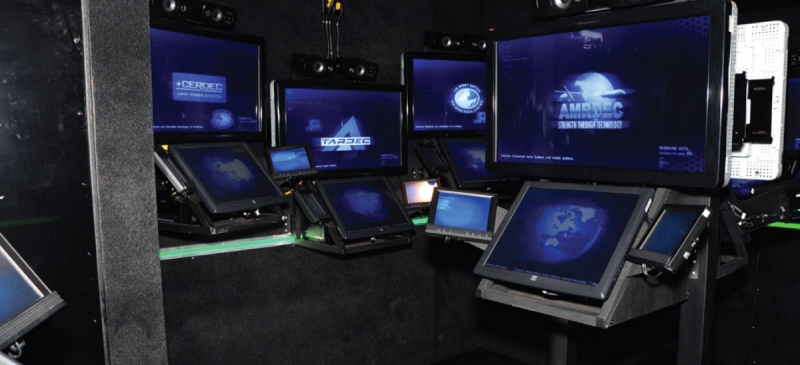The US Military’s Totally Cool Mobile Enlistment Exhibits

Image: The Extreme Truck, a 15,700-pound mobile recruitment vehicle that roams the country dazzling prospective soldiers. Photo courtesy of the US Army
For decades, the US military has been using souped-up mobile exhibits to recruit prospective soldiers. In July of this year, the military deployed the latest addition to a fleet that roves the country hoping to win the hearts and minds of American youth. The new vehicle, known as the Extreme Truck, is equipped with two 32-inch gaming stations, a 60-inch flat-screen television, several smaller TVs, and pull-up and push-up platforms. It has its own Facebook page, which, at press time, has been liked 111 times.
According to Mobile Exhibit Company commander Captain Korneliya Waters, who recently talked to Recruiter Journal, the Extreme Truck is "a symbol of independence and power." Her description reminded me of the jacket Nicolas Cage wears in Wild at Heart, which, for him, "represents a symbol of my individuality and my belief in personal freedom." Except the Extreme Truck is funded by tax dollars and designed to assist in contractually binding young people to America's wars.
Recruiting vehicles have been around in some form or another since 1936, when the government established the US Army Accessions Support Brigade, the only department of the Army dedicated exclusively to marketing (the MEC falls under its purview). Three years later, the secretary of the Army sent a team of soldiers to operate a high-profile mobile exhibit at the New York World's Fair.
The military expanded its marketing efforts dramatically in the 1970s, when it lost unfettered access to new recruits after the draft was repealed. In 1973, the year the all-volunteer force was instituted, the Army launched its first successful campaign-"Join the People Who've Joined the Army"-with the help of advertising agency N. W. Ayer & Son. In 1991, Colin Powell, then chairman of the Joint Chiefs of Staff, announced plans to expand the Junior Reserve Officers' Training Corps-a program that instructs high school students in basic training skills-to 3,500 units in five years' time. Thanks to anti-recruitment activism, the plan slowed significantly. Today, JROTC units, which are filled with MEC vehicles and exhibits, are about to reach that goal. And as Sam Diener, a visiting professor of peace studies at Clark University, notes, "Both the ROTC and the military recruiting trucks are ways in which youth in the United States are militarized."
By 2013, MEC vehicles drove a collective 600,000 miles to more than 48 states. USAASB operations stopped at more than 1,200 high schools in 2011. "The people who advise the armed forces on marketing are the top advertisers in the profession. And the audience they are seeking are millennials," says Rick Jahnkow, an anti-recruitment activist.
Another mobile unit, the STEM experience truck, is plastered with pictures of young people dressed as astronauts and staring intently into microscopes, and is pitched to aspiring engineers and scientists. Once inside, the visitor encounters a depressing scenario: The year is 2032, and there's been an attack on a chemical plant in Eastern Europe. An officer then leads the visitor to a screen, where he or she can choose from a range of tactical counterinsurgency options, including the use of drones. Speaking of which, the MEC currently operates three trucks that contain aerial simulators-the most recent being a UAV, or drone, simulator.
"The STEM truck in particular is used to gain access instead of recruiting a certain kind of student. They try to get cooperation from science teachers and math teachers," Jahnkow told me.
In June 2006, the first of 50 new H3 Hummers hit the road to increase interest in recruiting events. At the time, Sergeant First Class Anthony J. Colarusso told Recruiter Journal, "The H3 is a real 'icebreaker' in itself, so it should allow recruiters the ability to attract bigger crowds, which will allow us to work our magic." In the same issue, United States Recruiting Command director Donald Bartholomew referred to the Hummers as "just another tool in our kit-admittedly a really big one-that will turn heads and get feet moving toward the sound and excitement." That would be the sound of a $9,000 entertainment system that blasts waves of rap and death metal at potential recruits.
The MEC also offers things called "Immersa-Domes," weapons simulators, and various other interactive semis, including one that has the capacity to switch from "game mode" to "classroom mode" so students can watch videos about anti-bullying campaigns and basic training in the same sitting.
Late adolescence is an impressionable age, but the military is after kids who are even younger. If you meet GI Johnny, an inflatable goofy-grinned doll dressed in Army fatigues, and you're young enough to believe you've met a real person, then you are too young to start thinking about enlisting. But that's exactly the age group the Army has gone after lately. Sergeant Laddie Matula, who helped operate GI Johnny at a rodeo in an undisclosed American town, recounted the experience positively to the Recruiter Journal back in 2007, saying, "Parents love to bring up their little kids to meet with Johnny... Teachers take pictures while their kids shake my hand. The kids love it. The little kids are very comfortable with Johnny." Just this past spring, GI Johnny started tweeting-to little fanfare.
The military is not at all coy about its intentions to make as many impressions as possible on the emerging generation of recruits. While the media knocks itself out trying to make sense of what a millennial is, the military already has its sights set on what they call "Generation Edge." In the September/October 2013 issue of Recruiter Journal, Steve Lambert contributed a short op-ed titled "Advertising Update: Know Your Audience: Generation Edge," in which he argues that although millennials are "digital disciples and highly sociable," new recruiting tactics need to be developed now to attract the next generation of cadets. Generation Edge (those born since 1995) are, in his estimation, drawn to messaging that promotes the "three R's": "resilient," "resourceful," "realistic."
 Image: Screens in the STEM experience truck display fictional news coverage of a chemical attack in the year 2032. Photo courtesy of the US Army
Image: Screens in the STEM experience truck display fictional news coverage of a chemical attack in the year 2032. Photo courtesy of the US Army
Some will argue that these marketing schemes pale in comparison to the kinds of career opportunities the armed forces can provide. To demolish this argument you only need to consider the ripe age at which many recruits agree to the life-altering commitment of enlisting, the fact that war is hell, and the high rates of homelessness, unemployment, mental illness, and substance abuse among veterans.
But in the case of the MEC's efforts, another question emerges: one of privacy, consent, and equitable access. Diener says that the idea of giving equal access to the military and anti-recruiting efforts "goes back to the 1980s, when we noticed that the military recruiters were having essentially free access to high schools across the country, so students were getting a very one-sided view of the military."
But the purpose of these vehicles, as stated by the military in its own publications, is to give the military a distinctly unequal edge, by parking at high schools they might not usually have access to, collecting data from students, making impressions, and, ultimately, producing leads on future recruits. USAREC Regulation 601-93, which went into effect in July 1996, outlines the uses of the support unit. The regulation explicitly states that USAREC should "schedule in the primary market whenever possible (i.e., HS and colleges). Priority should go to the hard-to-penetrate schools."
In 2011, USAASB had more than 230,000 visitors, producing approximately 88,000 leads. The leads are gathered and sorted using a system perhaps not ironically named I-ELMO, which stands for Interactive Electronic Leads Management Options. According to Jahnkow, it is commonplace for recruiters to require all students to fill out personal information before participating in the interactive war games. This information is then transmitted into I-ELMO and comes out the other end as thousands of targeted campaigns to potential recruits.
In other words, it would seem that these trucks aren't symbols of independence or power, or any other beliefs. They're well-funded marketing tools that project fantasies custom-made for teens and steer young people onto the warpath, leaving so many unexplored roads in the dust.
Source: Vice
Countering Military Recruitment

WRI's new booklet, Countering Military Recruitment: Learning the lessons of counter-recruitment campaigns internationally, is out now. The booklet includes examples of campaigning against youth militarisation across different countries with the contribution of grassroot activists.
You can order a paperback version here.








